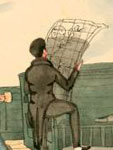Making the Most of Maps
Question

When a group of students has no prior experience or knowledge of using geography and maps in a social studies class, what are some ways that map/geography skills can be incorporated into a lesson?
Answer
To some extent the answer to this question depends on the age of the children you are teaching. Given the abstract nature of maps, formal introduction to map skills is likely best done after age six. For these young learners, I suggest that you look at the newly redesigned National Geographic Education website that includes a mini-lesson on "What is a Map." This lesson introduces the concept of a map as a simplified model of reality. From there one of the best ways to introduce map reading is to create a map of a familiar area (such as the classroom) together. That and other elementary geography projects can be found on this teacher-created site.
For slightly older students map skills should include learning the vocabulary of maps: words and concepts such as legends, scales, and compass roses. Instruction can also begin to focus on the concept that mapmakers must be selective and can show only a limited number of things on each map. Try this lesson from the United States Geological Survey that gets to this point. In any case, it is important to teach students about maps and how to use them before asking them to read and analyze content-specific maps.
Once students have a basic understanding of maps, teachers can begin to explore the use of maps to highlight important historical concepts. Elementary school is not too early to begin this type of lesson. A video example of using maps to teach history in a 4th-grade classroom can be explored here. The main goal in this lesson is to engage students in actively asking questions of the primary source document (in this case John Smith's map of Tidewater Virginia) and interpreting and understanding what they are seeing.
The Library of Congress has a large collection of maps that can be used for historical study. The site also has a self-directed professional development module for teachers about how to access and use maps in social studies lessons. This module is useful if you are new to using maps to teach history. To learn even more about what to look for in historical maps I encourage you to read the short demonstration essay "Making Sense of Maps" by David Stephens of Youngstown State University.
High school students with weaker geography backgrounds may require a review of terms and fundamental spatial concepts. But it is even more important for this age group for you to teach dynamic geographic analysis skills. See this Teaching Guide that includes an easy-to-use 12-step handout to guide questioning about a map. It not only lists what to look for in a map, but also engages students in asking their own questions about what is represented (and what is not) and how that influences our understanding of the map. As with other print media, students must learn to ask why was this document made, for whom, and in what context.
Finally, I am excited by the new uses for older maps that are afforded by the new Geographical Information Systems (GIS) technologies. An example of a high school lesson plan using interactive mapping features can be found here. This is just one of several history lesson plans based on GIS technology that are becoming available.
In sum, a myriad of historical maps can now be found on the Internet and their use is just beginning to be fully explored by teachers. There are so many kinds of maps. Let your imagination run free. Become familiar with the types of materials that are out there and the ways in which they might be used and then try them out with your classes. A good starting point for looking for maps can be found online here, here, and here as well as at the Library of Congress. As a geography buff, I love the number and quality of teaching materials that are now available. Kids like to work with maps and geography is fun to teach. Good luck!
